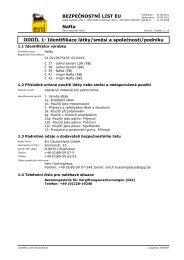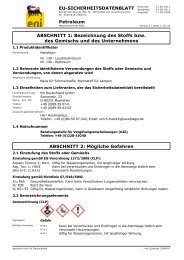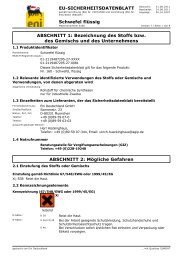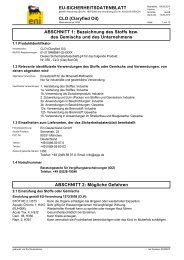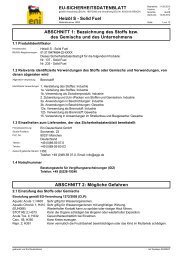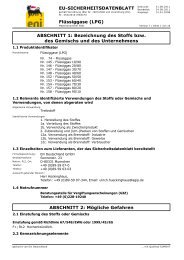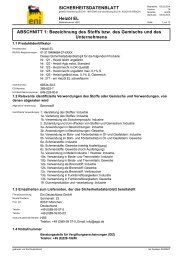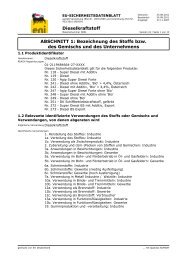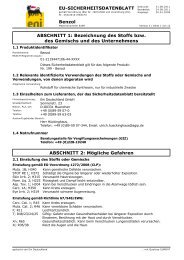EU-SICHERHEITSDATENBLATT Dieselkraftstoff ... - Schmierstoffe
EU-SICHERHEITSDATENBLATT Dieselkraftstoff ... - Schmierstoffe
EU-SICHERHEITSDATENBLATT Dieselkraftstoff ... - Schmierstoffe
You also want an ePaper? Increase the reach of your titles
YUMPU automatically turns print PDFs into web optimized ePapers that Google loves.
Vacuum Gas Oils, Hydrocracked Gas Oils, and Distillate Fuels<br />
Drum/batch transfers (Nondedicated<br />
facility) CS8,<br />
CS82<br />
Drum/batch transfers<br />
(dedicated facility) CS8,<br />
CS81<br />
Spraying/fogging by<br />
machine application CS25<br />
Manual applications e.g.<br />
brushing, rolling CS13<br />
Dipping, immersion and<br />
pouring CS4<br />
Equipment cleaning and<br />
maintenance CS39<br />
Wear gloves tested to EN374 PPE15<br />
Wear gloves tested to EN374 PPE15<br />
Minimise exposure by partial enclosure of the operation or equipment and<br />
provide extract ventilation at openings E60 Ensure operation is<br />
undertaken outdoors E69 Wear gloves tested to EN374 PPE15<br />
Wear chemically resistant gloves (tested to EN374) in combination with<br />
specific activity training PPE17<br />
Wear chemically resistant gloves (tested to EN374) in combination with<br />
‘basic’ employee training PPE16<br />
Drain down system prior to equipment break-in or maintenance.<br />
E65.Wear chemically resistant gloves (tested to EN374) in combination<br />
with ‘basic’ employee training PPE16<br />
Store substance within a closed system. E84<br />
Store substance within a<br />
closed system. E84<br />
Additional information on the basis for the allocation of the identified OCs and RMMs is<br />
contained in Appendices 2 to 3<br />
Section 2.2 Control of environmental exposure<br />
Product characteristics<br />
Substance is complex UVCB [PrC3]. Predominantly hydrophobic [PrC4a].<br />
Amounts used<br />
Fraction of <strong>EU</strong> tonnage used in region 0.1<br />
Regional use tonnage (tonnes/year) 3.1e4<br />
Fraction of Regional tonnage used locally 0.0005<br />
Annual site tonnage (tonnes/year) 1.5e1<br />
Maximum daily site tonnage (kg/day) 4.2e1<br />
Frequency and duration of use<br />
Continuous release [FD2].<br />
Emission days (days/year) 365<br />
Environmental factors not influenced by risk management<br />
Local freshwater dilution factor 10<br />
Local marine water dilution factor 100<br />
Other given operational conditions affecting environmental exposure<br />
Release fraction to air from process (initial release prior to RMM) 0.95<br />
Release fraction to wastewater from process (initial release prior to 0.01<br />
RMM)<br />
Release fraction to soil from process (initial release prior to RMM) 0.04<br />
Technical conditions and measures at process level (source) to prevent release<br />
Common practices vary across sites thus conservative process release estimates used [TCS1].<br />
Technical onsite conditions and measures to reduce or limit discharges, air emissions and<br />
releases to soil<br />
Risk from environmental exposure is driven by freshwater sediment [TCR1b].<br />
If discharging to domestic sewage treatment plant, no onsite wastewater treatment required [TCR9].<br />
Treat air emission to provide a typical removal efficiency of (%) N/A<br />
Treat onsite wastewater (prior to receiving water discharge) to provide 12.2<br />
the required removal efficiency (%)<br />
If discharging to domestic sewage treatment plant, provide the required 0<br />
onsite wastewater removal efficiency of (%)<br />
Organisation measures to prevent/limit release from site<br />
Do not apply industrial sludge to natural soils [OMS2]. Sludge should be incinerated, contained or<br />
reclaimed [OMS3].<br />
Conditions and measures related to municipal sewage treatment plant<br />
2010-07-30 CSR 173




